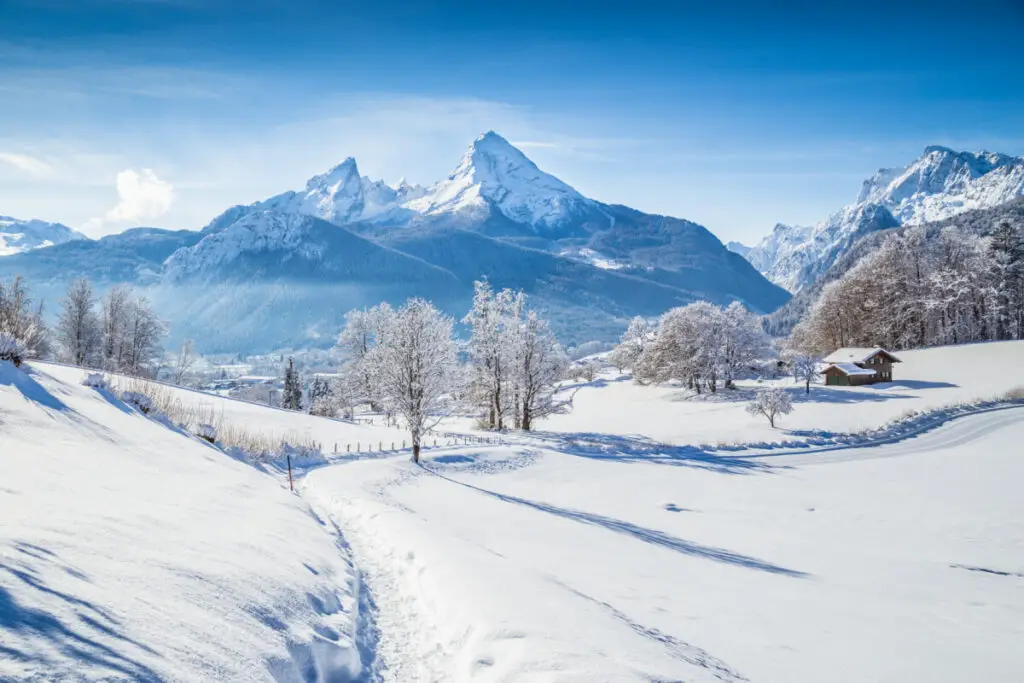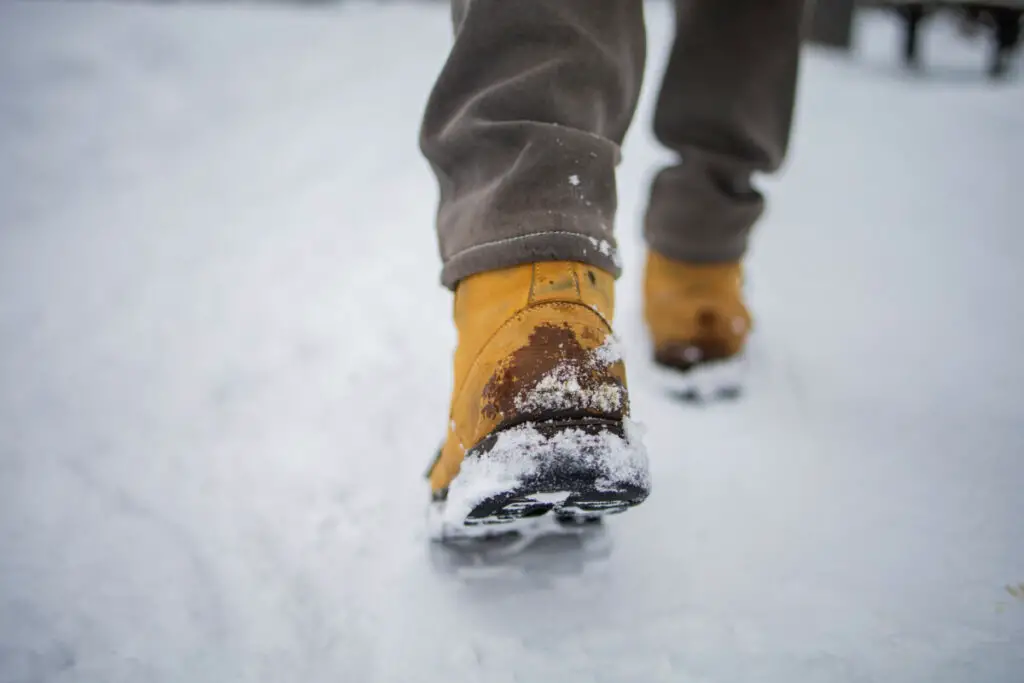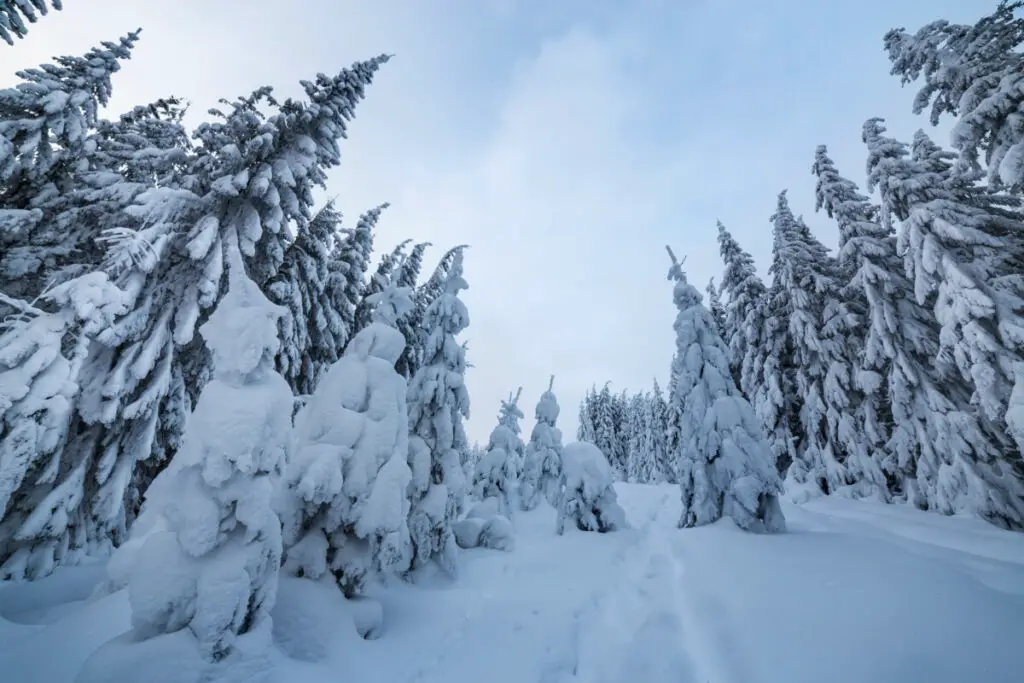
Buying high-quality hiking boots can be expensive, so you want to be able to use them in multiple types of terrains, including snow. That being said, it’s always more important to put safety first than it is to save money. However, are hiking boots good in the snow?
Hiking boots are good in light snow and icy terrain. However, they are unsuitable for heavy or packed snow, like the type that might be found on a popular hiking route in winter after a heavy snowfall. Hikers who plan on visiting such an area should invest in snow boots to prevent injury.
But what’s the difference between hiking boots and snow boots? And when is it better to use one over the other?
Can Hiking Boots Be Used in Snow?
Hiking boots are at their most useful when they are used on difficult terrain for extended periods of time. Of course, snow counts as difficult terrain, but the fact is that there are a few qualities of snow that make hiking boots a lot less useful than you might expect. (Source)
The first is that snow can only exist in the cold. Hiking boots are designed to be breathable, which is important if you’re going to be hiking for an extended period of time. It prevents your feet from getting soaked with sweat or being too uncomfortably hot. However, this turns into a huge liability in cold environments.
The breathability of hiking boots allows the cold air to easily get to your feet, which can make them uncomfortably cold when you aren’t actively moving. If your feet get wet because your boots aren’t properly waterproofed, the cold will be twice as bad.
Compounding this problem is the hiking boot’s lack of insulation. Because they are built to be breathable and prevent overheating, they tend to let out warmth easily. This is great in most weather but can be bad in cold, wet conditions.
The second quality of snow that hiking boots can’t easily beat is that it piles up. Unlike rain, which most hiking boots are designed to handle, snow doesn’t accumulate in puddles or run-down drains. Instead, it can pile up to be several feet high after a couple of days, easily getting over the height of most common hiking boots. (Source)
Because of this, it’s possible when in particularly deep snow to end up with the shoe covered in snow above the top, which even for very well waterproofed boots will result in snow entering the boot.
While this may seem bad, in many situations hiking boots may actually do fine. If the snow doesn’t get higher than the edge of the boot, the temperature is only in the mid to low 30s (Fahrenheit), or the snow is limited to a couple of small piles on the trail, hiking boots should be well-equipped to handle the situation.
However, if snow is piled up above the edge of the boot, the temperature is freezing, or if there’s a lot of heavily packed snow on the trail, snow boots may be the best choice.
Hiking Boots vs. Snow Boots
Both hiking and snow boots are designed with the purpose in mind of keeping hikers comfortably on their feet. This means they should have good traction and solid ankle support. They also are both likely to have at least some waterproofing, as hikes often take place near water. (Source)
Hiking boots are much lighter than snow boots. Since snow boots are built to insulate the foot and keep snow out even when immersed, they need to use heavier materials that are harder to puncture and can create a kind of seal around the lower leg.
Hiking boots, on the other hand, don’t need to seal or insulate and can get away with letting in a little bit of water, as they aren’t meant to be submersed very often. This means they can be made out of much lighter, more breathable materials. (Source)
Hiking boots also come in a higher variety of different heights, to better serve people with differing ankle support needs. Snow boots all tend to be similar heights compared to their shoe size since their primary purpose is to keep people’s feet and lower legs dry.

When to Use Hiking Boots
Hiking boots can be worn in most weather conditions, but the subject of this article is cold weather hiking so that’s where we’ll focus our eye. Hiking boots are built with traction and all-day use in mind. This makes them ideal in most conditions, even when there is some snow accumulation and even ice.
It’s always dangerous to stand on a slippery surface like a wet rock or a patch of ice, but hiking boots are meant to mitigate that danger. The strong traction that they can get is just about as good as is possible in many situations, which means that whatever the conditions are they should sufficiently decrease the risk of falling.
However, hiking boots lack the waterproofing integrity to keep snow out when entirely buried in it. This means that when hiking through snow taller than the height of the boot, it becomes inevitable that some snow will enter the boot, which, as anyone with experience in below-zero conditions can tell you, is not at all a pleasant situation to be in.
But, to put the importance of having the right footwear in perspective, having wet feet in the cold drastically increases the risk of both hypothermia and frostbite, two conditions that can be deadly. Even though snow boots may be less comfortable than hiking boots, keeping your body safe is worth the discomfort even for extended hikes.
A good rule of thumb is that if the snow outside is taller than your foot, you should be wearing snow boots. If it’s shorter, hiking boots will do fine. You should also wear snow boots if your feet are cold enough that it’s making you uncomfortable, as this is a sign that you may be at risk of hypothermia.
Hiking boots are suboptimal for packed snow. While this can be mitigated with the application of aftermarket devices designed to increase traction, it’s important to note that snow boots are built to easily grip packed snow, which makes them easier to use in places where packed snow might pose a slipping hazard.
Hiking boots are also worse when used away from established trails in the snow. Usually, their thick soles and great traction are great for trailblazing, but in the snow, the increased likelihood of accidentally stepping in a snowdrift that comes with leaving the trail makes them a lot riskier.
Can Snow Boots Be Used for Hiking?
While snow boots are needed for hikes in deep snow, they are generally bad for other kinds of hiking. They tend to lack the support that makes hiking boots great, which may seem like it isn’t a big deal until you’ve tried hiking without those supports for ten miles or so. This lack of support increases the likelihood of suffering sprains and strains alongside being generally uncomfortable.
Snow boots also aren’t really breathable, which can cause overheating and heavy sweating in the feet, which can get uncomfortable. A good pair of hiking socks can make this problem a little less bothersome, but can’t fix it entirely.
This being said, it doesn’t really make sense to assess the usefulness of snow boots outside of their intended purpose. You shouldn’t try to use them as year-round hiking boots, but you shouldn’t try to go hiking in the snow without them either. They are incredibly useful tools in the proper context and should be treated as such.
Waterproofing Hiking Boots
If you plan on taking hiking boots out into the snow, no matter how much snow you’re dealing with you’ll need to make sure those boots are waterproof. As mentioned earlier, getting wet feet in a cold environment can end up being a lot more dangerous than you might expect, which makes keeping them dry all the more critical.
If you have the time to select a good pair of hiking boots, picking a pair that’s waterproof can be a good start. Look for boots made with Gore-Tex, which is just about the best waterproof material out there. Boots treated with Gore-Tex should be able to keep pretty much any water out.
That being said, even Gore-Tex has its limits. If the boot has significantly sized holes for laces or a tongue that doesn’t seal against the boot, water will get in if it hits the top of the boot. This also applies to sections of boot that are made of a different material, which can easily let in water if exposed to it.
While the lack of top sealing can be mostly solved by tucking the legs of your snow pants into your boot, if your experience with your boot tells you that it isn’t fully waterproof, you should figure out where the weak spots are and make an effort to cover them, either with a waterproofing agent or with a tape that won’t cause the boot damage.
Leather is usually not waterproof, although it is somewhat water-resistant. If your hiking boots are made from leather and not specifically treated for water resistance, then you can assume that they are not waterproof. They will need to be treated.
While there are plenty of great waterproofing agents on the market, they can generally be separated into wax and fluoropolymer waterproofers. While wax-based products are best used on leather, fluoropolymer products can usually be used on any boot.
Of the wax-based products, Sno-Seal is the best. While it does have its detractors, many people will swear by it. Of course, applying it does require a fair amount of time and an oven, but with sufficient planning, this should be no barrier. (Source)
As for fluoropolymer, which can be used with Gore-Tex or cloth shoes, ReviveX and Grangers can both be used to some effect. That being said, with any waterproofing it’s impossible to stop all water from being able to soak through cloth or leather. If you end up stomping through the snow for hours you’re bound to end up with wet feet any time you aren’t wearing specialized snow boots.
You may find various DIY waterproofing tips at home, which can range from covering your shoes in melted candle wax to using petroleum jelly. Be careful using these methods on expensive hiking boots, as you only have to melt the soles once with burning wax to ruin your boots forever, and the limited water resistance they may provide is unlikely to be worth the risk.
Foot Safety in Cold Weather

We’ve talked a lot about how important it is to keep your feet dry when it’s cold outside, but there are other important steps that you should always take during cold-weather activities to prevent frostbite and other ailments commonly caused by cold weather.
It’s hard to overstate the importance of warm socks. While snow boots can get you part of the way to warm feet with good insulation, if you’re planning on wearing hiking boots good socks are a must-have. Wool is best, as it can retain warmth even if it gets wet.
As with any hike, preventing blisters is important for having a good time in cold weather. The difference is that when it’s cold, you might not necessarily get a chance to tend to any hotspots that may arise during the course of normal hiking, as it’s risky to take off your boots in cold the cold without a source of warmth nearby like a fire or a heating pad.
In order to mitigate your chances of getting a blister, make sure your boots fit properly. This will prevent unnecessary friction inside the boot itself, which can often cause blisters. (Source)
If your boots are too big, consider getting inserts for them to help them fit better. Double socking is not recommended, as wearing two pairs of socks can often cause friction between the two pairs which negates the point of filling out the shoe.
Preventative blister creams are also unadvisable in cold weather, as they can freeze on your foot, which not only makes it less effective at preventing blisters, but will also make your feet uncomfortably cold.

